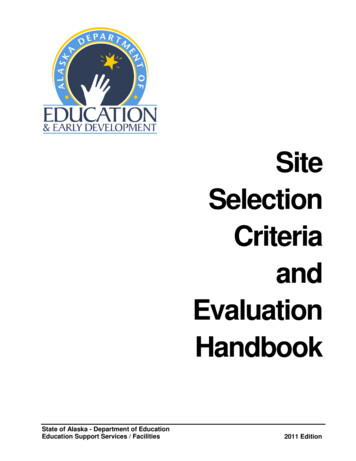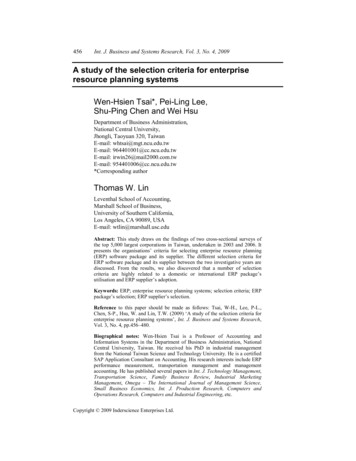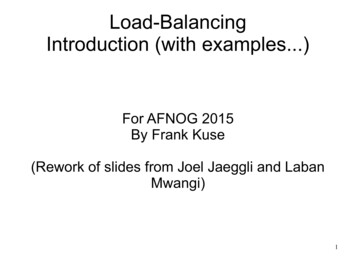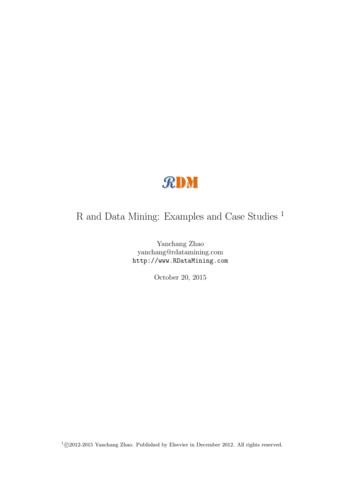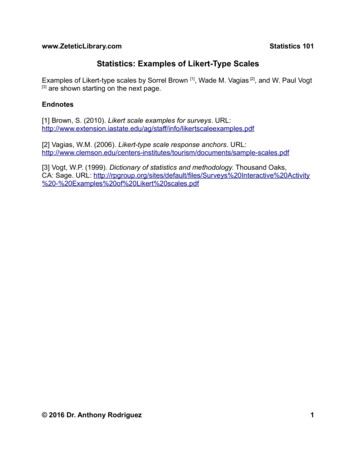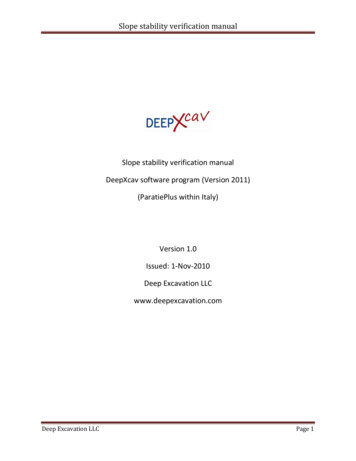
Transcription
Copyright 2011 by SelectionCriteria-Examples.comFirst published April 2011Written by Scott WilliamsVersion v1.01http://www.selectioncriteria-examples.comThe purchase of this publication entitles the purchaser to one copy of the publication.All rights reserved. No part of this book may be used or reproduced by any means, graphic,electronic, or mechanical, including photocopying, recording, taping or by any informationstorage retrieval system without written permission except in the case of short quotationsembodied in critical articles and reviews and when otherwise granted. Please visitwww.SelectionCriteria-Examples.com for permission requests.DisclaimerPlease be aware that the information presented represents the expressed views of the authorsunless otherwise cited. Please use discretion in the implementation of all examples. WhileSelectionCriteria-Examples.com offers the information and examples for the benefit of itsreaders, please be cautious and wise in its use.People and companies mentioned are purely fictitious and any resemblance to real people orcompanies is completely coincidental.This publication is sold on the condition that:The editor and authors expressly disclaim all forms of liability to any person (purchaser of thispublication or not) in respect of the publication and any consequences arising from its use.www.SelectionCriteria-Examples.comPage 2
CONTENTSCONTENTS . 3INTRODUCTION . 6PART ONE . 7THE AUSTRALIAN PUBLIC SERVICE . 8Introduction. 8Australia’s federal civil service – the APS . 8APS grades . 9APS salaries. 9Government jobs outside of the APS .10SELECTION CRITERIA.11Introduction. 11What are selection criteria? .11Selection criteria in the APS .11Essential vs. desirable selection criteria.12Types of selection criteria and the Integrated Leadership System .12TOOLS AND STRATEGIES FOR WRITING A STATEMENT OF CLAIMS AGAINST SELECTION CRITERIA .15Introduction. 15The Statement of Claims .15How should you address the selection criteria? .15Addressing selection criteria – a step-by-step example .16Addressing selection criteria – things to avoid .18www.SelectionCriteria-Examples.comPage 3
PART TWO .21“SUPPORTS STRATEGIC DIRECTION” .22APS1 to APS4 . 22APS5 to EL1 .25EL2 to SES3 .28“ACHIEVES RESULTS” .31APS1 to APS4 . 31APS5 to EL1 .34EL2 to SES3 .37“SUPPORTS PRODUCTIVE WORKING RELATIONSHIPS”.40APS1 to APS4 . 40APS5 to EL1 .43EL2 to SES3 .46“DISPLAYS PERSONAL DRIVE AND INTEGRITY” .49APS1 to APS4 . 49APS5 to EL1 .52EL2 to SES3 .55“COMMUNICATES WITH INFLUENCE”.58APS1 to APS4 . 58APS5 to EL1 .61EL2 to SES3 .64PART THREE .67OTHER SELECTION CRITERIA .68ADMINISTATION .68ANALYTICAL OR CONCEPTUAL SKILLS/ATTENTION TO DETAIL .69www.SelectionCriteria-Examples.comPage 4
APS VALUES/APS CODE OF CONDUCT.70COMPUTER SKILLS .71CUSTOMER SERVICE .72MANAGEMENT .73OCCUPATIONAL HEALTH & SAFETY (OH&S) .74PRIORITISING AND MEETING DEADLINES .75PROJECT MANAGEMENT .76SUPERVISION .77TEAMWORK .78TRAINING STAFF .79WORKING EFFECTIVELY AS AN INDIVIDUAL/ALONE .80www.SelectionCriteria-Examples.comPage 5
INTRODUCTIONHello and welcome to this e-book, entitled: “Selection Criteria Complete Examples”.It can be used when applying for Australian Government jobs.The idea of this book is simple: to enable you to get to the interview stage in the job applicationprocess for a government job with the minimum of effort. You will still have to do some work inapplying, but the ‘grunt work’ will be done for you by this book.The material that follows is split up into three parts. In Part One, we introduce our topic, talkabout the Australian Public Service and about selection criteria in general terms.In Part Two, we move on to what makes up the bulk of the e-book: 45 separate examples, splitinto three pay grades, of how to address specific selection criteria that will come up for justabout any Australian Public Service job.In Part Three, we’ll address some selection criteria that weren’t covered in Part Two – somethat are less critical than those in Part Two, but which are still common and important to cover.www.SelectionCriteria-Examples.comPage 6
PART ONEwww.SelectionCriteria-Examples.comPage 7
THE AUSTRALIAN PUBLIC SERVICEIntroductionIt might be the case that you already know a lot about the Australian Public Service. Perhapsyou’ve worked for the Australian Public Service; perhaps you’re even currently working for theAustralian Public Service. If that’s the case, some of the material in this book, and particularly inthis Part, will already be familiar to you, because for safety’s sake this book assumes that youdon’t have any familiarity with it.That’s why it’s appropriate to begin with a little background on the Australian Public Serviceitself.Australia’s federal civil service – the APSThe Australian Public Service, better known to almost everyone in its orbit as the ‘APS’, isAustralia’s federal civil service. The APS is consists of the people variously employed by bodiessuch as government departments, government agencies and the courts to carry out Australia’spublic administration.Collectively, the APS is a very large employer indeed. In June 2010, the APS had 164,596employees (defined as people employed under the Public Service Act 1999). The number ofemployees grew every year between 2000 and 2010, but the rate of growth slowed between2007 and 2010.The 164,596 employees that the APS had in June 2010 were divided into 150,871 ongoingemployees and 13,275 non-ongoing employees.The three largest APS agencies in terms of employees have in recent decades have beenCentrelink, the Australian Taxation Office, and the Department of Defence.Most APS employees are women: in June 2010, 57.4% of ongoing employees and 61.4% of nonongoing employees were women (57.7% overall).More APS employees work in the Australian Capital Territory (36%) than in any one other stateor territory.The typical APS position is a desk job with a generic job title, but the APS also employsbiologists, zoologists, oceanographers, fisheries scientists, economists, meteorologists,environmental scientists, designers, curators, city planners, meat inspectors and more.www.SelectionCriteria-Examples.comPage 8
APS gradesAPS jobs are graded for seniority and responsibilities. The first block of grades are the six ‘APS’grades, from APS 1 to APS 6. APS 1 is the most junior grade, APS 6 the most senior. Then thereare the two ‘Executive’ grades, Executive Level 1 (‘EL 1’) and Executive Level 2 (‘EL 2’). Finallythere are the three ‘Senior Executive Service’ grades, from 1 to 3. Senior Executive Service 1(‘SES 1’) is the lowest of these grades, and Senior Executive Service 3 (‘SES 3’) is at the very topof the whole tree.The Senior Executive Service forms the senior leadership group of the Australian Public Service.The role of the SES is to provide professional expertise and policy advice within the APS, and soSES people are expected to have high level management and leadership skills.APS salariesAlong with seniority and responsibility, the APS grades also determine relative salary levels.Salaries for each grade sit within a band; exactly how much an employee of a given grade
The idea of this book is simple: to enable you to get to the interview stage in the job application process for a government job with the minimum of effort. You will still have to do some work in applying, but the ‘grunt work’ will be done for you by this book. The material that follows is split up into three parts. In Part One, we introduce our topic, talk

